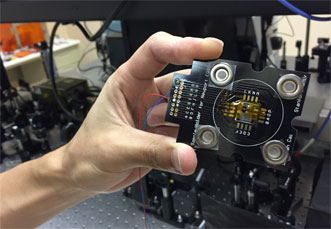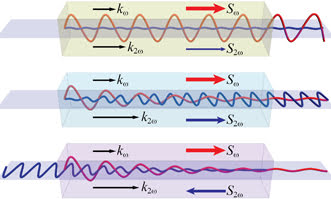ATLANTA, June 16, 2015 — A metamaterial waveguide has demonstrated opposite refractive indices at the fundamental and harmonic frequencies of light, confirming for the first time a decade-old theoretical prediction.
The experimental verification of backward phase matching – a phenomenon also known as the "nonlinear mirror" – may have few immediate practical applications, according to the Georgia Institute of Technology team that created the waveguide. But it is a milestone that could also lead to new areas of study, they said.
"Nonlinear optics is critically important to controlling light for information processing, sensing and signal generation," said Wenshan Cai, an associate professor in Georgia Tech's School of Electrical and Computer Engineering, who led the research team. "Our effort substantially expands the scope of nonlinear light-matter interactions in artificially structured media with engineered, unconventional linear and high-order material parameters."

A metamaterial waveguide at the center of a silicon chip has opposite refractive indices at the fundamental and harmonic frequencies of light. Courtesy of John Toon/Georgia Tech.
Engineered metamaterials offer unique properties not available in natural materials. This is especially useful in nonlinear optics, where materials with unconventional properties could make a difference anywhere light must be actively controlled. Researchers at multiple institutions have already created optical metamaterials that could be used to produce more efficient solar cells, faster computer chips, improved sensors and even limited invisibility cloaks.
"The linear responses of metamaterials have substantially augmented the linear properties available from naturally occurring materials," Cai said. "In the same way, the studies of nonlinear metamaterials may have a revolutionary impact on the field of nonlinear optics. The unconventional electromagnetic parameters made possible by metamaterials will provoke us to rethink and re-evaluate many of the established rules of nonlinear optics."
Experimentally, the researchers struggled to create a negative-index material – which has been a holy grail for metamaterial research – with a sample size large enough for testing. They had to tailor the refractive indices at both the fundamental and harmonic frequencies simultaneously.

Phase matching conditions for second-harmonic generation (SHG) in nonlinear optical media. (a) Low-efficiency frequency doubling of light in a positive-index medium without phase matching. (b) Conventional phase matching for SHG, where the fundamental and harmonic waves possess the same index of refraction and co-propagate along the same direction. (c) Backward phase-matching in a negative-index material, where the frequency-doubled signal is directed towards the source of the fundamental wave. The red- and blue-colored lines in the schematics represent the fundamental and second-harmonic waves, respectively. Courtesy of Wenshan Cai/Georgia Tech.
The research team demonstrated backward phase matching by exploiting two distinct modes in a nonlinear plasmonic waveguide, which was built with a thin dielectric spacer of relatively high refractive index sandwiched between two flat silver films. A large dielectric constant in the gap enabled a pronounced separation of the surface plasmon and bulk plasmon frequencies, while a narrow gap pushed the operating point away from the surface plasmon frequency and helped balance the magnitudes of the refractive indices of the two modes.
The waveguide operated with the real part of the mode refractive indices at 3.4 and –3.4 for the fundamental and harmonic waves, respectively. The observed peak conversion efficiency at the excitation wavelength of about 780 nm indicated fulfillment of the phase matching condition, in which the coherent harmonic wave emerged along a direction opposite to that of the incoming fundamental light, the researchers said.
Metamaterials obtain their properties from a repeated unit structure rather than the constituent materials. At the frequency range between visible and IR light, subwavelength metallic structures can serve as building blocks – essentially "meta-atoms" – to create optical materials with properties that have not been available in the past.
Normal phase matching is a standard technique to achieve efficient frequency generation using nonlinear optics, usually achieved by fine-tuning the orientation or temperature of a nonlinear crystal, Cai said. In second-harmonic generation, phase matching requires that the refractive index of the initial (fundamental) and the doubled (harmonic) frequencies be identical. That way, the fundamental light will gradually be converted to its harmonic along the direction of propagation, and the output harmonic light will copropagate along the same direction.
"Beyond the backward phase matching, there are many other intriguing phenomena in nonlinear metamaterials awaiting exploration," Cai said. "The ability to design custom, nonlinear materials, which is possible in metamaterials, is bound to open entirely new outlooks for nonlinear light-matter interactions."
The research was published in Nature Materials (doi: 10.1038/nmat4324).
For more information, visit www.gatech.edu.